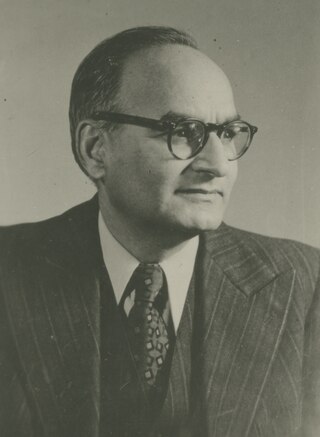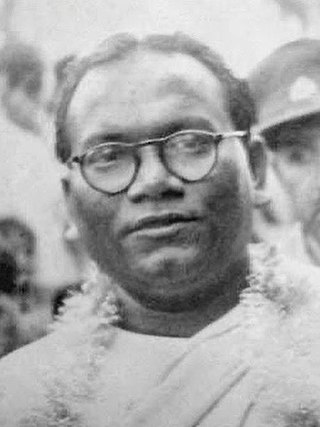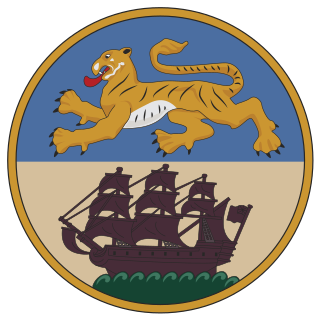Related Research Articles

East Pakistan was the eastern province of Pakistan between 1955 and 1971, restructured and renamed from the province of East Bengal and covering the territory of the modern country of Bangladesh. Its land borders were with India and Burma, with a coastline on the Bay of Bengal. East Pakistanis were popularly known as "Pakistani Bengalis"; to distinguish this region from India's state West Bengal, East Pakistan was known as "Pakistani Bengal". In 1971, East Pakistan became the newly independent state Bangladesh, which means "country of Bengal" or "country of Bengalis" in Bengali language.

Chaudhri Muhammad Ali was a Pakistani politician and statesman who served as the fourth prime minister of Pakistan from 1955 until his resignation in 1956. His government transitioned Pakistan from a British Dominion to an Islamic Republic.

Huseyn Shaheed Suhrawardy was a Pakistani Bengali barrister and politician. In Bangladesh, Suhrawardy is remembered as a pioneer of Bengali civil rights movements, later turned into Bangladesh independence movement, and the mentor of Bangladesh's founding leader Sheikh Mujibur Rahman. He is also remembered for his performance as the Minister for Civil Supply during the Bengal famine of 1943. In India, he is seen as a controversial figure; directly responsible for the 1946 Calcutta Killings, for which he is often referred as the "Butcher of Bengal" in West Bengal.

The Bengali language movement was a political movement in East Bengal in 1952, advocating the recognition of the Bengali language as a co-lingua franca of the then-Dominion of Pakistan to allow its use in government affairs, the continuation of its use as a medium of education, its use in media, currency and stamps, and to maintain its writing in the Bengali alphabet / Bengali script

Constituent Assembly of India was partly elected and partly nominated body to frame the Constitution of India. It was elected by the Provincial assemblies of British India following the Provincial Assembly elections held in 1946 and nominated by princely states. After India's independence from the British in August 1947, its members served as the nation's 'Provisional Parliament', as well as the Constituent Assembly. It was conceived and created by V. K. Krishna Menon, who first outlined its necessity in 1933 and enshrined it as an Indian National Congress demand.

Abul Kasem Fazlul Huq, popularly known as Sher-e-Bangla, was a Bengali lawyer and politician who presented the Lahore Resolution which had the objective of creating an independent Pakistan. He also served as the first and longest Prime Minister of Bengal during the British Raj.

The Lahore Resolution, also called the Pakistan Resolution, was a formal political statement adopted by the All-India Muslim League on the occasion of its three-day general session in Lahore, Punjab, from 22 to 24 March 1940, calling for a separate homeland for the Muslims of British India.

The Partition of Bengal in 1947, also known as the Second Partition of Bengal, part of the Partition of India, divided the British Indian Bengal Province along the Radcliffe Line between the Dominion of India and the Dominion of Pakistan. The Bengali Hindu-majority West Bengal became a state of India, and the Bengali Muslim-majority East Bengal became a province of Pakistan.

The Dominion of Pakistan, officially Pakistan, was an independent federal dominion in the British Commonwealth of Nations, which existed from 14 August 1947 to 23 March 1956. It was created by the passing of the Indian Independence Act 1947 by the British parliament, which also created an independent Dominion of India.

East Bengal was the eastern province of the Dominion of Pakistan, which covered the territory of modern-day Bangladesh. It consisted of the eastern portion of the Bengal region, and existed from 1947 until 1955, when it was renamed as East Pakistan. East Bengal had a coastline along the Bay of Bengal to the south, and bordered India to the north, west, and east and shared a small border with Burma to the southeast. It was situated near, but did not share a border with Nepal, Tibet, the Kingdom of Bhutan and the Kingdom of Sikkim. Its capital was Dacca, now known as Dhaka.

The East Pakistan Provincial Assembly, known as the East Bengal Legislative Assembly between 1947 and 1955, was the provincial legislature of East Pakistan between 1947 and 1971. It was known as the East Bengal Assembly from 1947 to 1955 when the provincial name was changed. The legislature was a successor to the Bengal Legislative Council and the Bengal Legislative Assembly, which were divided between East Bengal and West Bengal during the partition of Bengal in 1947. It was the largest provincial legislature in Pakistan. Elections were held only twice in 1954 and 1970.

Dhirendranath Datta was a Bengali lawyer and politician from East Bengal who was a member of the 1st Constituent Assembly of Pakistan. He is best known for proposing Bengali for the national language of Pakistan in the Assembly. He was also active in the politics of undivided Bengal in pre-partition India.

Jogendranath Mandal emerged as a prominent figure among the architects of the nascent state of Pakistan. He served as the inaugural Minister of Law and Labour, as well as the subsequent Minister of Commonwealth and Kashmir Affairs. Within the Interim Government of India, he had previously held the portfolio of law. Distinguished as a leader representing the Scheduled Castes (Dalits), Mandal vehemently opposed the partition of Bengal in 1947. His rationale rested on the apprehension that a divided Bengal would subject the Dalits to the dominance of the majority caste-Hindus in West Bengal (India). Eventually opting to maintain his base in East Pakistan, Mandal aspired for the welfare of the Dalits and assumed a ministerial role in Pakistan as the Minister of Law and Labour. However, a few years subsequent to the partition, he relocated to India, tendering his resignation to Liaquat Ali Khan, the then Prime Minister of Pakistan, citing the perceived anti-Dalit bias within the Pakistani administration.

Nawab Sir Khwaja Salimullah Bahadur was the fourth Nawab of Dhaka and one of the leading Muslim politicians during the British rule in India.
United Bengal was a proposal to transform Bengal Province into an undivided, sovereign state at the time of the Partition of India in 1947. It sought to prevent the division of Bengal on religious grounds. The proposed state was to be called the Free State of Bengal. A confessionalist political system was mooted. The proposal was not put up for a vote. The British government proceeded to partition Bengal in accordance with the Mountbatten Plan and Radcliffe Line.

Al-Hajj Abd-Allah Zaheeruddin Moazzem Hossein Chowdhury, popular known as Lalmia, was a Bengali Muslim politician. He represented Faridpur District in the Bengal Legislative Council, the Constituent Assembly of Pakistan, and National Assembly of Pakistan. He was Pakistan's federal Minister of Health, Social Welfare and Labour in the cabinet of Ayub Khan.
The Krishak Sramik Party was a major anti-feudal political party in the British Indian province of Bengal and later in the Dominion of Pakistan's East Bengal and East Pakistan provinces. It was founded in 1929 as the Nikhil Banga Praja Samiti to represent the interests of tenant farmers in Bengal's landed gentry estates. Sir Abdur Rahim was its first leader. A. K. Fazlul Huq was elected leader in 1935 when the former was appointed as the president of the Central Legislative Assembly of India.

Greater Bangladesh, or Greater Bengal is an irredentist ideology that wishes for Bangladesh to expand its territory to include the Indian states that currently has, or historically had, large populations of ethnic Bengali people. These include West Bengal, Bihar, Odisha, and Jharkhand to the west, Sikkim to the north, and the states of Arunachal Pradesh, Assam, Meghalaya, Tripura, Mizoram, Manipur, and Nagaland to the east.

The Nizam-e-Islam Party or simply Nizam-e-Islam, is a religious-political party in Bangladesh and Pakistan. The party was founded in the city of Kishoreganj in 1952, by the Islamic scholars of erstwhile East Bengal, Pakistan as an offshoot of the Jamiat Ulema-e-Islam. It was one of the four political parties belonging to the United Front alliance which defeated the Muslim League in the 1954 elections.

The Bengal Legislative Assembly was the largest legislature in British India, serving as the lower chamber of the legislature of Bengal. It was established under the Government of India Act 1935. The assembly played an important role in the final decade of undivided Bengal. The Leader of the House was the Prime Minister of Bengal. The assembly's lifespan covered the anti-feudal movement of the Krishak Praja Party, the period of World War II, the Lahore Resolution, the Quit India movement, suggestions for a United Bengal and the partition of Bengal and partition of British India.
References
- 1 2 "The man who played a role in the politics of India, Pakistan and Bangladesh". ThePrint. 25 August 2018. Retrieved 11 March 2022.
- 1 2 3 4 5 6 7 8 9 10 "The Bengal contingent at the Constituent Assembly". Get Bengal. Retrieved 11 March 2022.
- 1 2 "STRANDED PAKISTANIS: DID THEY COMMIT SOME MISTAKES OF JUDGMENT? By: FAIZ AL-ALNAJDI - South Asian Pulse". www.sapulse.com. Retrieved 11 March 2022.
- ↑ Ghosh, Papiya (21 March 2014). Partition and the South Asian Diaspora: Extending the Subcontinent. Routledge. p. 9. ISBN 978-1-317-80966-1.